Both chemotaxis and net motility greatly influence the infectivity of Vibrio cholerae
- PMID: 15037750
- PMCID: PMC387366
- DOI: 10.1073/pnas.0308052101
Both chemotaxis and net motility greatly influence the infectivity of Vibrio cholerae
Abstract
The role of chemotaxis in the virulence of gastrointestinal pathogens is ill defined. Counterintuitively, nonchemotactic mutants of the polarly flagellated pathogen Vibrio cholerae greatly out-compete the wild-type strain during infection of the small intestine. We show that the out-competition phenotype is dependent on the direction of flagellar rotation and independent of Toxin Co-regulated Pilus function. Specifically, the out-competition associated with the loss of chemotaxis required the presence of counterclockwise-biased flagellar rotation and smooth straight runs by the bacteria. In contrast, a nonchemotactic strain with clockwise-biased flagellar rotation was confined to small-scale net movement and was attenuated for infection. The significance of the out-competition phenotype was examined and was shown to correlate with a true increase in infectivity. Counterclockwise-biased mutants are aberrantly distributed throughout the infant mouse small intestine and we find that the expression of virulence factors occurs normally in all segments. Thus, alteration of the chemotactic properties of V. cholerae allows it to exploit additional niches in the host intestine.
Figures




References
-
- Eisenbach, M. (1990) Mol. Microbiol. 4, 161-167. - PubMed
Publication types
MeSH terms
Substances
Grants and funding
LinkOut - more resources
Full Text Sources

